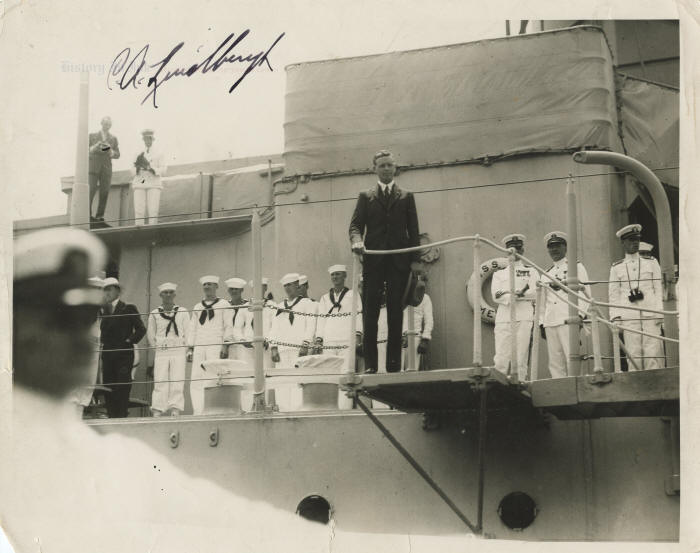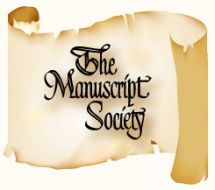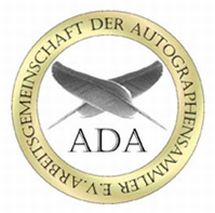2112302
Charles A. Lindbergh
Scroll down to see images of the item below the description
Historically important signed photo of Lindbergh acknowledging the crowd from the deck of the USS Memphis
upon his arrival in the United States after his celebrated solo nonstop transatlantic flight
Charles Augustus Lindbergh, 1902–1974. American aviator; first pilot to fly solo across the Atlantic Ocean; recipient of the Congressional Medal of Honor; first recipient of the Distinguished Flying Cross. Vintage glossy black-and-white 8” x 10” photo signed C. A. Lindbergh.
This historically important photograph shows the 25-year-old Lindbergh on the deck of the USS Memphis on June 11, 1927, acknowledging the crowd upon his arrival in the United States following his famous solo transatlantic flight. Lindbergh, dressed in a suit and tie and carrying his hat, stands in front of the ship’s commander, Vice Admiral Guy Burrage, and several other naval officers and sailors. Two photographers stand on a platform above Lindbergh, and another officer, his image blurred by proximity to the camera, is at the lower left.
Lindbergh set out alone to fly from New York to Paris in pursuit of the Orteig Prize, a $25,000 reward for the first Allied pilot or pilots to fly across the Atlantic Ocean between the two cities in one flight. With long-distance aviation still in its infancy, others before Lindbergh had died trying to win the prize.
But Lindbergh succeeded—becoming an international megastar in the days before megastars existed. Although others had flown nonstop across the Atlantic eight years earlier, Lindbergh was the first to do so solo.
The flight was a feat of raw courage. Lindbergh had to stay awake during the 33½ hours that it took him to fly the 3,610-mile route. Once he was over water, landing to abort the flight—even an emergency crash landing—was not an option.
Lindbergh flew the specially designed Ryan Airlines Spirit of St. Louis, a single-seat, single-engine monoplane modeled after the Ryan M-2, which was used for air mail service. In order to carry enough fuel for the length of the flight, the plane had five fuel tanks, two of which were installed in the forward section of the fuselage for balance and safety.
But the Spirit of St. Louis had no navigation radio because Lindbergh eliminated it to reduce the plane’s weight. The plane had no front windshield because of the fuel tanks, so Lindbergh could see ahead only by maneuvering the plane to look forward out of a side window. The plane’s cockpit was so small—36” x 32” x 51”—that the 6’3” pilot could not stretch his legs. Flying as far north as Newfoundland, Lindbergh chilled in the cold cockpit as ice formed on the struts of the plane’s wings. He flew southward whenever possible in order to keep his instruments from freezing over, but he ran into a magnetic storm that caused his compasses to malfunction anyway.
To avoid clouds and fog, Lindbergh flew as low as 100 feet above the ocean, but when the cloud ceiling descended to the water, he flew shrouded in clouds at 1,500 feet for two hours, unable to see anything outside. The farther the flight progressed, too, the more Lindbergh had to fight the urge to sleep. He descended close to the water so that ocean spray could splash his face. After flying nearly 24 hours, he began to sense spirits behind him in the cockpit, spirits that he said gave him advice on the flight. Finally, thankfully, after seeing mirages that he thought was land, he sighted the coast of Ireland, the coastline matching his map, and knew that he would soon be over France.
When Lindbergh arrived at Le Bourget Aerodrome outside of Paris, some 150,000 people witnessed him land and then stormed his plane. Overnight, “the wonders of modern communications” flashed word of his successful flight and made Lindbergh “the most famous man on earth.” A. Scott Berg, Lindbergh 135 (1998). Lindbergh was repeatedly fêted in Paris, where American flags flew everywhere and the French president awarded him the Légion d’honneur. A crowd estimated at up to 1,000,000 people lined the streets to watch Lindbergh’s procession through the city to the Hôtel de Ville, the Paris City Hall, where he appeared on the balcony before some 35,000 people in the square. He was deluged by so much correspondence that he hired a trust company to handle it for him. He was hounded by hundreds of members of the press who wanted interviews and photographs and by hoards of everyday people who just wanted a glimpse of him. He flew to Belgium, where thousands of people awaited his arrival to meet with Belgian King Albert and his family. He then flew to Britain, where thousands of British waited to see him land at Croydon and lined the roads and streets as he went to London to visit Prime Minister Stanley Baldwin at 10 Downing Street, King George V and Queen Mary at Buckingham Palace, and the Prince of Wales, who would later be King Edward VIII, at York House.
Lindbergh planned to tour Europe and then return to the United States through Greece, Asia, and the Pacific, flying the rest of the way around the world. But the demand for his return home was too great. President Calvin Coolidge ordered the USS Memphis, which had deck space enough to carry the crated Spirit of St. Louis, to bring Lindbergh home by sea.
When the Memphis entered Chesapeake Bay on June 10, 1927, it was joined by a four destroyers, two Army blimps, and 40 airplanes. By the time the Memphis passed Alexandria, Virginia, on its way up the Potomac River to Washington, D.C., the number of planes had increased to 88. President and Mrs. Coolidge invited Lindbergh’s mother, Evangeline Lindbergh, to accompany them to the Washington naval yard, where members of the Cabinet, the heads of the armed services, and thousands of spectators strained to see “the tall, slim young man in the blue suit on the bridge, holding his hat with one hand and waving with the other. A volley of gun salutes cracked the air, punctuating the roar of the crowd.” Berg, Lindbergh, at 153.
This photograph documents Lindbergh’s appearance on deck. “As the anchor was dropped and the gangway fastened, Admiral Burrage led Lindbergh to the bow for a long welcoming cheer.” Id. A pencil note on the back of this photo notes “Lindbergh / On return to USA at Wash Navy Yard / over 300 photographers & newsreel were there to greet him.”
This vintage glossy photo is thus an important piece of history. Our research has found only one other signed photograph of Lindbergh on board the Memphis upon his arrival home, but it showed Lindbergh walking alone with Vice Admiral Burrage. This signed image of Lindbergh acknowledging his rousing reception may well be unique.
Lindbergh has signed with a beautiful black fountain pen signature in the white area at the upper left. The photo has small tears at the bottom and left edges; there is a bend to the upper right corner; the upper left corner is missing; and the photo shows some handling. There are also three small ink circles on the back, but they do not show through. The defects do not affect the signature and do not diminish the historical importance of this piece, which is in very good to fine condition overall.
Unframed.
This item has been sold.







